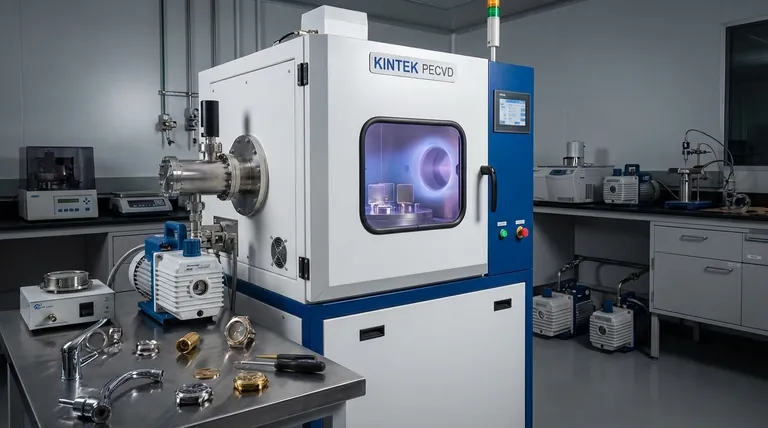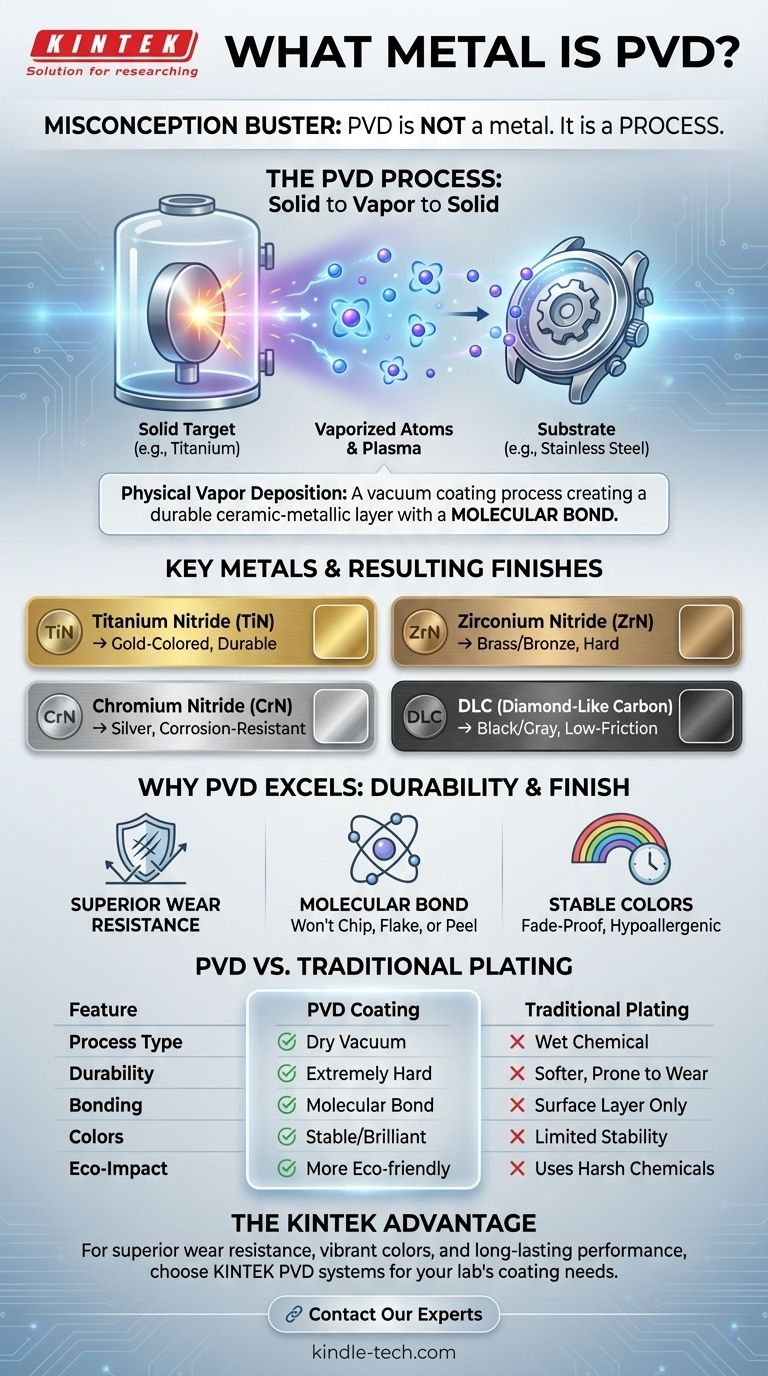Contrary to a common misconception, PVD is not a type of metal. Instead, PVD—which stands for Physical Vapor Deposition—is a sophisticated vacuum coating process used to apply a very thin but extremely durable layer of metal onto another material, typically stainless steel. The metals most commonly used for the coating itself are titanium, zirconium, and chromium.
The key takeaway is that when you see a product labeled "PVD," you are not buying an object made from a new kind of metal. You are buying a product, often made of steel, that has been enhanced with a high-performance ceramic-metallic coating for superior color, durability, and resistance to scratches and corrosion.

What is PVD? A Look Inside the Process
Physical Vapor Deposition is a state-of-the-art finishing process that creates a molecular bond between the coating and the base material (the substrate). This makes the surface finish significantly harder and more durable than traditional plating methods.
From Solid to Vapor to Solid
The name "Physical Vapor Deposition" perfectly describes the process. Inside a high-vacuum chamber, a solid piece of a target metal (like titanium) is vaporized into a plasma of atoms. This metal vapor then deposits, atom by atom, onto the object being coated, forming a thin, perfectly uniform, and bonded film.
The Role of the Vacuum Chamber
The entire process occurs in a vacuum to prevent contamination from air or other particles. This pristine environment ensures the coating adheres with maximum strength and purity, creating a flawless finish that is an integral part of the final product, not just a painted-on layer.
Key Metals Used for PVD Coatings
While PVD is a process, it uses specific metals to achieve different colors and properties. The vaporized metal often reacts with gases introduced into the chamber (like nitrogen) to form ceramic compounds.
- Titanium Nitride (TiN): This is the most common PVD coating and is used to create a durable, tarnish-resistant gold-colored finish.
- Zirconium Nitride (ZrN): Used to produce brass, bronze, and light gold colors with exceptional hardness.
- Chromium Nitride (CrN): Provides a very hard, corrosion-resistant, and metallic silver appearance.
- DLC (Diamond-Like Carbon): Often applied via a PVD process to create extremely hard, low-friction surfaces in shades of graphite gray and deep black.
Why PVD Excels in Durability and Finish
PVD is not just for color; its primary benefit is a massive increase in the wear resistance of the product's surface. It is the preferred finish for high-end watches, kitchen and bath fixtures, tools, and medical implants.
More Than a Layer of Paint
Unlike electroplating or powder coating, which simply sit on the surface, PVD coatings are molecularly bonded to the substrate. This means the finish will not chip, flake, or peel away.
Superior Wear and Corrosion Resistance
The resulting ceramic-metal layer is incredibly hard—often significantly harder than the steel underneath. This makes PVD-coated products highly resistant to scratches and scuffs from daily use. The coating also seals the substrate, protecting it from corrosion, tarnishing, and discoloration from UV light.
A Spectrum of Stable Colors
PVD allows for a wide range of brilliant, stable colors like gold, rose gold, black, bronze, and gunmetal. Because the color is an intrinsic part of the bonded coating, it won't fade over time or react with your skin, making it an excellent choice for jewelry and watches.
Understanding the Trade-offs and Nuances
While superior, PVD is not a magical solution. Its effectiveness depends on the entire system, and it is important to have realistic expectations.
PVD vs. Electroplating
Electroplating is a "wet" process that uses an electrical current in a chemical bath to deposit a thin layer of metal. It is generally less expensive than PVD but is also significantly softer, more prone to scratching, and can tarnish or wear off over time. PVD is a "dry" vacuum process that is more durable, harder, and more environmentally friendly.
The Importance of the Substrate
A PVD coating is only as good as the material underneath it. A high-quality PVD finish on a cheap, soft base metal like a zinc alloy will not prevent the object itself from denting. For true durability, look for PVD coatings applied to a solid substrate like 316L stainless steel.
Is PVD "Scratch-Proof"?
No finish is completely scratch-proof. PVD is highly scratch-resistant. It can easily withstand the wear and tear of daily life, but a deep gouge with a sharp object can still penetrate the coating and damage the substrate below.
Making the Right Choice for Your Goal
Now that you understand PVD is a process, not a material, you can better evaluate products.
- If your primary focus is maximum durability for an everyday item (like a watch or faucet): Prioritize products that explicitly state they have a PVD coating on a solid stainless steel base.
- If your primary focus is a specific, long-lasting color (like black or gold jewelry): PVD offers a fade-proof and tarnish-resistant finish that is hypoallergenic and will not react with your skin.
- If you are evaluating cost: PVD-coated products are more expensive upfront than plated alternatives, but their longevity and resistance to wear make them a more cost-effective investment over time.
By understanding PVD as a process of enhancement, you can confidently choose products built for lasting performance and enduring quality.
Summary Table:
| Aspect | PVD Coating | Traditional Plating |
|---|---|---|
| Process Type | Dry vacuum deposition | Wet chemical bath |
| Durability | Extremely hard, scratch-resistant | Softer, prone to wear |
| Bonding | Molecular bond to substrate | Surface layer only |
| Common Colors | Gold, black, bronze, gunmetal | Limited color stability |
| Environmental Impact | More eco-friendly (no harsh chemicals) | Uses chemical solutions |
Ready to enhance your products with durable PVD coatings? KINTEK specializes in advanced lab equipment and consumables for surface treatment and materials science. Our PVD systems and expertise help you achieve superior wear resistance, vibrant colors, and long-lasting performance for your applications. Contact our experts today to discuss how we can support your laboratory's coating and finishing needs!
Visual Guide

Related Products
- RF PECVD System Radio Frequency Plasma-Enhanced Chemical Vapor Deposition RF PECVD
- Chemical Vapor Deposition CVD Equipment System Chamber Slide PECVD Tube Furnace with Liquid Gasifier PECVD Machine
- VHP Sterilization Equipment Hydrogen Peroxide H2O2 Space Sterilizer
- Molybdenum Tungsten Tantalum Special Shape Evaporation Boat
- Split Chamber CVD Tube Furnace with Vacuum Station Chemical Vapor Deposition System Equipment Machine
People Also Ask
- What is the principle of plasma enhanced chemical vapor deposition? Achieve Low-Temperature Thin Film Deposition
- How are PECVD and CVD different? A Guide to Choosing the Right Thin-Film Deposition Process
- Why does PECVD commonly use RF power input? For Precise Low-Temperature Thin Film Deposition
- What are the applications of PECVD? Essential for Semiconductors, MEMS, and Solar Cells
- What is an example of PECVD? RF-PECVD for High-Quality Thin Film Deposition



















